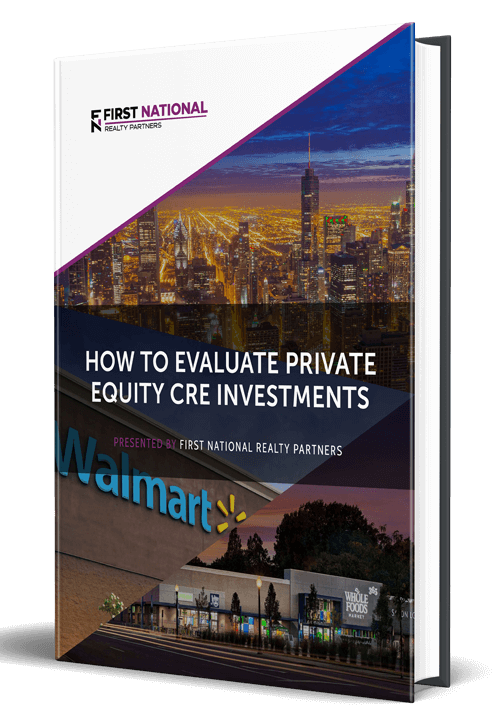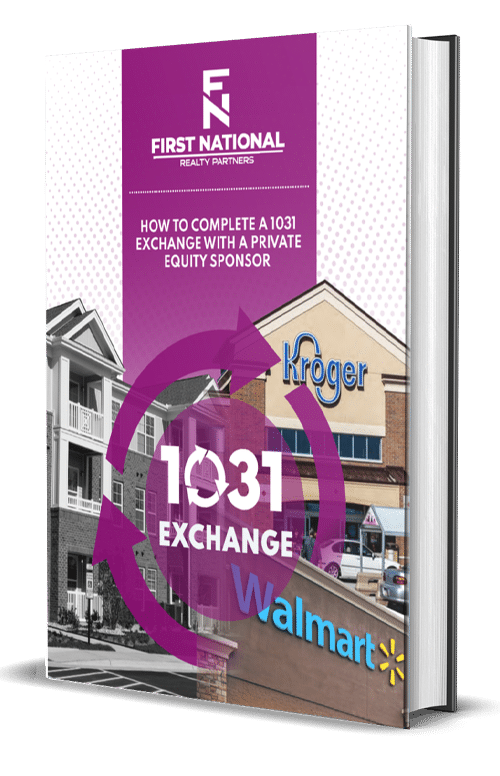The goal of every commercial real estate investment is the same, to earn a return on invested capital. Typically, this is achieved by purchasing an investment property at a good price, earning a stream of income over a defined holding period, and then (hopefully) selling the property for more than the purchase price. In order for the property to sell for more than the purchase price, it must experience price appreciation.
In this article, we are going to explore the relationship between a rental property’s cap rate and price appreciation. To do so, we will define what a cap rate is, describe how it is calculated, and identify how changes in it contribute to price appreciation. By the end, readers will be able to use this knowledge to evaluate the appreciation potential with commercial real estate investment opportunities.
At First National Realty Partners, we use the cap rate in all of our financial models to help identify which deals offer the best potential returns for investors. To learn more about our current investment opportunities, click here.
Capitalization Rates Explained
In order to understand the relationship between cap rates and price appreciation, it makes sense to start by defining exactly what a cap rate is.
In commercial real estate investment, a property’s cap rate is a performance metric that describes the relationship between its net operating income (NOI) and its market value. The cap rate formula is:
Cap Rate = Net Operating Income / Property Value
In this equation, NOI is calculated as a property’s gross income minus operating expenses and property value is derived from the purchase price, estimate, or appraisal. The result is a percentage that provides real estate investors with two key pieces of information:
- The annual rate of return, assuming the property is purchased with cash
- The amount of risk associated with the property. A higher cap rate means higher risk, which is why the return has to be higher. A lower cap rate means lower risk, which is why investors are willing to accept a lower return. For example, lower risk property types like multifamily and office buildings tend to have a low cap rate. While higher risk properties like hotels and restaurants tend to have a high cap rate.
Because the cap rate measures risk and return, there is a direct relationship between it and how much the price of a property appreciates.
What Is Commercial Real Estate (CRE) Appreciation?
The concept of commercial real estate appreciation is a simple one. It means that the value of property rises over the course of the holding period. It can be measured over different time intervals, but is most commonly measured as the change between the purchase price and the sales price. For example, if a property is purchased for $100,000 and sold for $125,000, it “appreciated” in value by $25,000.
Generally, there are three ways that a property can experience price appreciation: through cap rate changes, through efficient management practices, or both.
How Cap Rates Affect Market Appreciation
When evaluating a property’s market, real estate investors are well served to choose one whose conditions are favorable for “cap rate compression.” In this scenario, market factors – like supply, demand, population growth, and rental rates – converge to convince investors that it is worthwhile to pay higher prices for a property, which is reflected in a lower cap rate.
For example, assume that a property with $100,000 in NOI was purchased at a 7% cap rate or $1.42MM. Also assume that five years after purchase, demand in the market has risen significantly. Population and job growth is high and investors are clamoring for properties. As a result, cap rates have fallen to 6%. Assuming the property has the same $100,000 in NOI, the new value at a 6% cap rate is $1.66M. In this scenario, market dynamics have driven cap rates lower and caused $240M in price appreciation.
How Efficient Management Affects Market Appreciation
Now assume that the same property with $100,000 in NOI was purchased at a 7% cap rate or $1.42MM. But, over the course of five years, the property owner has managed expenses, renegotiated some lease rates, and developed new streams of ancillary income. As a result, NOI has increased $125,000. Assuming the cap rate stays the same, the new value is $1.78MM, which is $360,000 higher than the purchase price.
The Ideal Scenario
The above examples are for illustrative purposes only. In reality, both NOI and the cap rate change over the term of the holding period. In an ideal real estate investing scenario, market forces drive cap rates lower and efficient management practices drive NOI higher.
If a property with $100,000 in NOI is purchased at a 7% cap rate, the price is $1.42MM. Now, assume that NOI rises to $125,000 and cap rates fall to 6%. The new value is $2.08MM, which is $660M higher than the purchaser price. This is the scenario that offers the highest price appreciation potential / return on investment. It is also the one that real estate investors are after when they acquire a property.
Summary of Cap Rate & Appreciation
A property’s capitalization rate is a performance metric that describes the relationship between its net operating income and its value.
The result of the cap rate calculation provides real estate investors with an idea of their potential annual return if the property was purchased with cash. In addition, it gives them an idea of the market’s assessment of the property’s risk level.
There is a direct relationship between a property’s level of price appreciation and its cap rate. When market dynamics are strong, cap rates are pushed lower, which causes the valuation to rise. Conversely, if market conditions are poor, cap rates rise and the value of the property is pushed lower.
The other way a property can appreciate in value, assuming the cap rate remains the same, is to increase the amount of net operating income that a property produces. Typically, this is accomplished through efficient management practices.
In an ideal scenario, market conditions drive cap rates down at the same time that efficient property management drives net operating income up. This is where the greatest price appreciation is achieved.
Interested In Learning More?
First National Realty Partners is one of the country’s leading private equity commercial real estate investment firms. With an intentional focus on finding world-class, multi-tenanted assets well below intrinsic value, we seek to create superior long-term, risk-adjusted returns for our investors while creating strong economic assets for the communities we invest in.
If you are an Accredited Real Estate Investor and would like to learn more about our investment opportunities, contact us at (800) 605-4966 or info@fnrpusa.com for more information.






